Diesel Service Report, April 17th, 2021
Fairbanks Morse Santa Fe SF560 Restoration
As noted previously, one exhaust manifold has serious condition problems. Corrosion has resulted in numerous holes that leak cooling water out onto the engine block. That manifold was removed and evaluated. The conclusion is that the bottom steel plate on the manifold, will have to be totally replaced or discard the complete manifold and replace it with a new or rebuilt one.
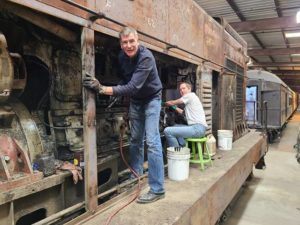 Advice from experts on this problem, indicate that this is a common failure associated with Fairbanks Morse locomotives and a common remedy is to cut out the corroded area and weld in patches. We have considered that but are very reluctant to do it. The steel that is corroded is severely bulged out of shape due to freezing at some time in its past and corrosion has set in. There are numerous holes through the whole length of the bottom surface of the manifold. Our only logical choice, if we want to retain this manifold, is to have the whole bottom plate removed and replaced. We have two options to consider. One is to have our volunteers do the work and the second option is to send it out to a local machine shop.
Advice from experts on this problem, indicate that this is a common failure associated with Fairbanks Morse locomotives and a common remedy is to cut out the corroded area and weld in patches. We have considered that but are very reluctant to do it. The steel that is corroded is severely bulged out of shape due to freezing at some time in its past and corrosion has set in. There are numerous holes through the whole length of the bottom surface of the manifold. Our only logical choice, if we want to retain this manifold, is to have the whole bottom plate removed and replaced. We have two options to consider. One is to have our volunteers do the work and the second option is to send it out to a local machine shop.
Of course, the other option is to buy replacement exhaust manifolds that have been tested for pressure. The water cooling portion of the manifolds , according to the manuals, is tested with 50 PSI. If we repair the existing manifolds, we will have to perform that pressure test before reinstalling them back into the locomotive.
John Salvini and Richard Berk have now removed the second manifold. It was also bulged from freeze damage but appears to have no corrosion leaks, yet. The experts claim that they typically reinstalled manifolds in that condition and do nothing about it until later if/when they fail. It appears that the second manifold may be OK to use once it passes a pressure test.
This picture (above) shows Bob Bray and Tim Johnson in the process of cleaning the area where the second exhaust manifold was removed.
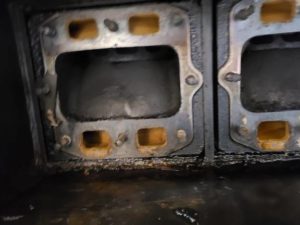
The area where the manifold sits, is a recessed box area built into the side of the engine. Cooling water comes into the manifold from the water pump, is partially heated there and is then routed to two separate areas. One area is the exhaust area right where it comes out of the cylinders and the other is the power cylinders, or liners as they are know. This is an extremely complicated arrangement.
In the picture (right), the large square opening is the area where exhaust gases exit the combustion area within the cylinders. The small rust-colored holes are the ports that feed water into the exhaust ports to keep them cool. The exhaust coming out of those large square holes is extremely hot and could easily damage the steel if there were no cooling in that area.
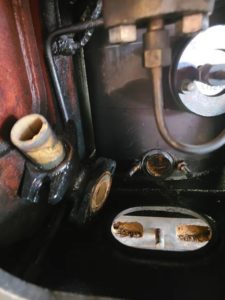
The next picture (left) shows the actual power cylinder directly in the middle of the picture. It has two studs protruding from an opening. That is the opening that takes cooling water from the exhaust manifold and routes it through the cylinder walls to keep them cool. On the left of the picture is a rust colored 90 pipe fitting. That bolts onto the exhaust manifold and routes water to the cylinder liners.
It is clear then that the exhaust manifolds are the main distribution devices for cooling water into the engine. It is critical that they function properly, and we really have no choice other than to ensure that we properly repair the existing exhaust manifolds or buy replacements.
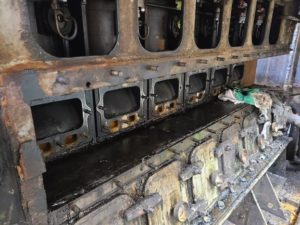 The problem with purchasing replacement manifolds will be the price. We know they will cost $7500 each plus shipping. That could easily eat up over $16,000. Our project budget was $40,000 before we knew about the manifold issue. If we have to buy exhaust manifold replacements, we will need to raise that amount plus about $20,000 that we are still short from the initial fund raising effort.
The problem with purchasing replacement manifolds will be the price. We know they will cost $7500 each plus shipping. That could easily eat up over $16,000. Our project budget was $40,000 before we knew about the manifold issue. If we have to buy exhaust manifold replacements, we will need to raise that amount plus about $20,000 that we are still short from the initial fund raising effort.
Even after a lot of cleaning, there is still lots more to do. This is by far, the biggest greasy mess that we have ever attempted clean up. SP1006 was bad but this is even worse. And its not in just one area in the engine compartment, it is everywhere.
EMD E8 Union Pacific 942
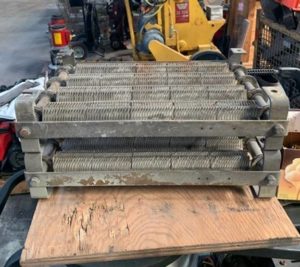 A few weeks ago, it was discovered that the main generator shunt field resistor was broken and needed to be replaced. Eric Levin located one for us and has shipped it. Once it arrives and is installed, the rear engine in the locomotive will develop twice the power that it has ever produced while we have owned the engine. Below is a picture of the “resistor”. Obviously, it’s a large resistor pack that can handle a lot of current and dissipate a lot of heat.
A few weeks ago, it was discovered that the main generator shunt field resistor was broken and needed to be replaced. Eric Levin located one for us and has shipped it. Once it arrives and is installed, the rear engine in the locomotive will develop twice the power that it has ever produced while we have owned the engine. Below is a picture of the “resistor”. Obviously, it’s a large resistor pack that can handle a lot of current and dissipate a lot of heat.
Open House
This next weekend we will be having our yearly special event where visitors can visit our work areas, which are normally off limits to them. In addition, there will be a special treat where SP3100 and UP942 will be operated in Multiple Unit operation. Obviously, we don’t need that much power to pull just a few passenger cars. But our visitors that day will be a lot of railroad fans that really look forward to seeing unique things like that.
50 Inch Sellers Wheel Lathe
Carl Pickus and Doug Newberry continue to clean and lubricate the various portions of the lathe. The left-hand cross feed mechanism now moves freely, and they are working on the right hand one. The plan is to have the building open for visitors to see the lathe operate next weekend during the open house event.
Dave Althaus

